You’re on a boat, and you see somebody fall into the water. Which of the following two cases would cause you to react with stronger emotion?
- The water is four feet deep and you know that the guy who fell in is a good swimmer
- The water is four feet deep and the person who fell in is a three year old girl who can’t swim
Presumably your emotional reaction would be stronger if the child fell off the boat. Because you know that the child’s life is at stake. The first situation is not life-threatening, the only thing at stake is the dryness of the man’s clothes and his self-esteem.
The degree you care about events that happen to people, and to yourself, is directly related to what’s at stake. This applies as much to fictional characters as in the real world.
Hence it is immensely important for storytellers to(more…)
In a story, if the treasure hoard is what the character wants, then slaying the dragon is the goal.
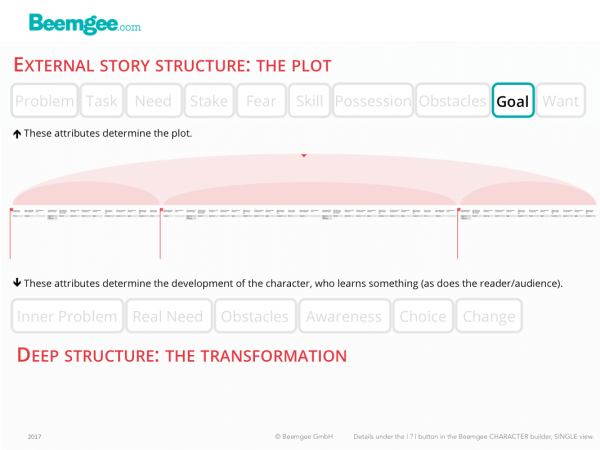
The goal is what the character thinks will lead to the want.
Since the hoard has been there for ages, there must usually be some sort of trigger for the story to get started, i.e. for the character to want the hoard now, at the time the story begins. Often, an external problem creates such a trigger. It might supply a reason why the hero needs the hoard now, something more specific than just the general sense of wanting to be rich. Perhaps the hoard isn’t the reason at all. Perhaps there is a princess in distress, which certainly adds urgency to the matter. Either way, dealing with the dragon is the goal.
If somebody says the word “goal” to you, the image that springs to mind might have to do with the ends of a football pitch. The(more…)
Stories are about people who want something.
We can distinguish between two different types of want:
- the wish, or character want
- the plot want
Marty McFly wishes to be a musician (character want). He also wants to get Back to the Future (plot want).
The wish or character want is a device which adds cohesion to the story, usually in the form of the set-up/pay-off. Marty is seen at the beginning of the film practicing the guitar; at the end of the film he plays at a concert. The wish is a useful technique to make the character clearer to the audience, but it is not essential to composing a story.
More important is what we have called the plot want. As a result of the external problem – the trigger event that sparks the chain of cause and effect which the bulk of the plot consists of –, the character feels an urge, which provides the motivation for the character’s actions in the story.
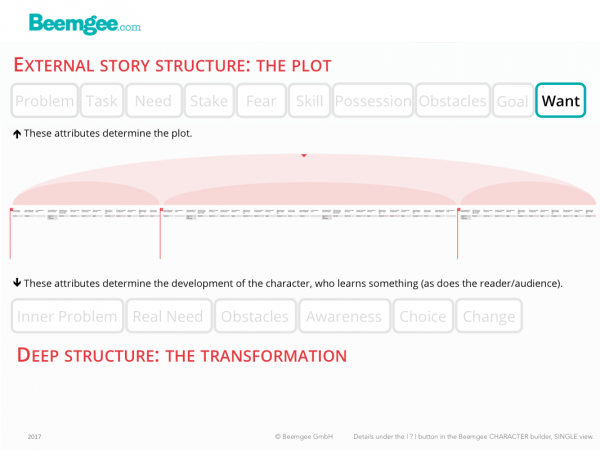
The want is the state after which the character strives, and is distinct from the goal.
In this post we’ll be talking about active vs. passive characters, motivation, the difference between a want and a goal, a couple of writer traps to avoid, and contradictory wants.
Active Characters
Characters have to be actively acting of their own volition. The want has to be urgent and strong enough for them to do things. If the want is missing or too weak, the character will lack motivation and appear passive. A passive character is usually not interesting enough to hold the audience’ or readers’ attention.
Why is this so?
An evolutionary explanation of stories as practice for problem-solving attempts to shed light on the phenomenon: When characters react to events rather than cause them, they appear weak, like victims. Which means that there is not much we can learn from them. Humans experience stories physically and emotionally (our hearts beat faster, our palms sweat), and since we learn from experience, we instinctively prefer stories which provide us with experiences that benefit us in some way. Which tends to be the case when we experience stories of self-motivated problem-solving.
Motivation
There is a good reason for that cliché about actors always asking about their motivation. It is motivation that prompts the characters in a story to do the things they do. Stories seem to work best not only when characters are active rather than passive, but often when they have comprehensible reasons for their activity.
The reason for what a character wants is usually comprehensible for the audience or reader because of the external problem. In simple terms, the character wants to solve the problem. Take the Cinderella story as an example. Her problem is that she is bound to the stepmother and her two nasty daughters.
In other words, the want is a vision the character has of his or her situation without the problem. Hence what the character wants is actually a particular state of being. Such a state might mean being in a position of wealth, power or respect, or being in a happily ever after relationship. Cinderella wants merely to be free of her involuntary servitude, if only for a little while.
This makes the want distinct from the goal, which is the specific gateway to the wanted state of being, as perceived by the character. A story usually sets up a goal the character needs to reach or attain in order to achieve the want. In Cinderella’s case, it is attending the ball.
So, a story has its characters pursue their wants. These different wants oppose each other, causing conflicts of interest. The conflicting wants make the characters active, and the audience/readers like stories about actions, that is, about characters who do things.
Sounds simple.
And yet frequently stories seem to mess up on this vital point.
Next to passive characters without a strong enough want, lack of clear motivation is a huge writer trap. It is possible to write a whole story full of characters who are reactive instead of active, or who do things of their own volition but without that volition being clearly recognisable to the audience/reader. It is perhaps even tempting to write stories like that, because they seem more lifelike. In real life, people do not necessarily have distinct goals. Often, our wants are vague and not clearly definable. What about writing a realistic story about a character with a general sense of dissatisfaction, who, like so many of us, has lost sight of any clear objective in life?
It’s doable, certainly. But the audience/readers will probably start to look for the specific want of such a character. They would probably begin to expect the story to be about this character’s search for a clear objective in life. That might be the want the audience would tacitly ascribe to the character.
And if the story does not bear such motivation out, the risk is significant. Because stories in which the audience does not understand what the characters want lack emotional impact.
Contradictory Wants
A way of adding psychological depth and emotional complexity to characters is to give them several and even contradictory wants. Gollum in Lord Of The Rings wants the ring. Yet a part of him also wants to give up the ring and help Frodo. Next to solving the case, Marty Hart in True Detective wants to be a good husband and family man, but he also wants affairs with other women. That’s three wants for one character.
Is it really always necessary for every character to have a clearly defined want?
No. Because, of course, there are exceptions. In certain cases, the author might deliberately obfuscate the why of a character’s actions in order to inject mystery. Not knowing something keeps the audience/reader guessing and turning the pages or not switching the channel. Usually this mystery is cleared up at some point. The audience tends to expect that. Which implies that even if the want was not made clear to the audience early in the story, it was there in the character nonetheless – and certainly the author was aware of it.
Injecting mystery in this way is not in itself a writer trap. But nearly. When tempted to use such a device, an author should at least consider if it would not actually be more interesting for the audience to know the character’s motivation.
Having said that, there are rare cases where a character’s motivation does remain unexplained. And those cases can be powerful. Especially when it’s a baddy we don’t understand.
Think of Iago in Shakespeare’s Othello, who is simply bad to the bone and we’ll never really know what made him so. Shakespeare – deliberately, one presumes – gives no hint as to what Iago hopes to achieve by ruining Othello. Shakespeare might easily have given Iago some clearly understandable motivation, such as revenge of a past wrong, envy of Othello’s success, desire to usurp Othello’s position, lust for Desdemona. But he didn’t. And Iago is one of the most superb villains ever.
But perhaps the most interesting thing about a character’s want is how it stands in conflict with what that character really needs.
Action is character.
So the old storytelling adage. What does that mean, exactly?
In this post, we’ll consider:
- The central or pivotal action – the midpoint
- Actions – what the character does
- Reluctance
- Need
- Character and Archetype
The central or pivotal action – the midpoint
More or less explicitly, the main character of a story is likely to have some sort of task to complete. The task is generally the verb to the noun of the goal – rescue the princess, steal the diamond. The character thinks that by achieving the goal, he or she will get what they want, which is typically a state free of a problem the character is posed at the beginning of the story.
The action is what, specifically, the character does in order to achieve the goal: rescue the princess, steal the diamond. In many cases, this action takes place in a central scene. Central not only in importance, but central in the sense of being in the middle.
Let’s look at some examples. (more…)
In most stories, the protagonist has something to do.
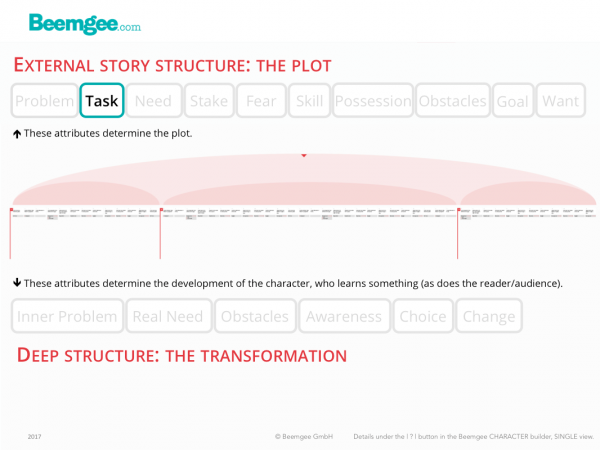
The task is the more or less explicitly defined mission a character sets out on in order to reach the goal and thereby solve the external problem.
Many of the major characters in a story will have something to do, which may result in them getting in each other’s way.
Task as Function
In a story, more or less everyone has a task. What characters do in a story defines them and determines their roles and narrative functions in the story. In this sense, it is an antagonist’s task to get in the way of the protagonist; an ally’s task is to help the protagonist; a mentor’s task is to advise the protagonist and set them on their way.
But while all that is true, it isn’t really what we mean by task.
Task as Action
The characters’ actions make them who they are. To define a character’s task is to state clearly what that character has to achieve in the story. It is the action that leads to(more…)
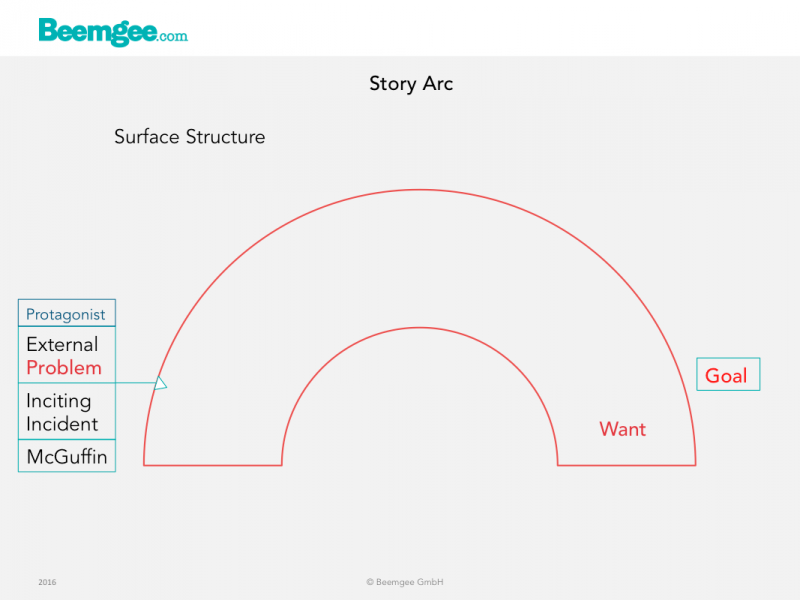
In storytelling, a McGuffin (or MacGuffin) is something that the protagonist is after – along with most other characters in the story.
The use of a McGuffin is a device the author employs in order to give a story direction and drive.
Easy to spot McGuffins are the Ark of the Covenant in Raiders Of The Lost Ark, the statuette in The Maltese Falcon, private Ryan in Saving Private Ryan, the ring (more specifically, the act of its destruction) in Lord Of The Rings. Note how in these examples, the McGuffin is in the title of the story. The McGuffin may be so deeply embedded in a story structure that it becomes what the story is about, on the surface at least.
Typical genres that have McGuffins are comedy, crime, adventure, fantasy and other quest stories. But conceivably, a dressed up McGuffin might be found in any genre.
Nor does a McGuffin have to be an object. It could be a person or a quality. In a story of several characters vying for the love of one other character, that love might be considered the McGuffin. A place might become a McGuffin too – consider the role of the planet Earth in Battlestar Galactica.
In terms of narrative structure, a McGuffin occupies the(more…)
In storytelling, a character’s intellectual stance determines his or her choice of actions – at least in his or her conscious mind.
The intellectual stance is the articulated version of a character’s emotional stance.
Now, it may be nit-picking to make the distinction. But then again, it might be quite helpful to see by what line of reasoning a character justifies his or her behaviour.
The effect can be powerful when there is a discrepancy (i.e. conflict) between what the character thinks is the reason for his or her actions and the real reason. When the audience or readers see that the words and thoughts of a character do not match with what that character is actually motivated by, the irony can be a satisfying story experience.
At the root of it is story’s predisposition for cause and effect. The intellectual stance is the effect, the emotional stance the cause.
Actions create(more…)
A character in a story has beliefs, values, ideas, passions. In short, an emotional stance. It’s this bundle of feelings that make the character a character.
By emotional stance we mean belief-system and value-set. This is particularly important when one considers that often stories show value-sets in conflict, and the theme of the story may present one of these value-sets as preferable over the other.
An emotional stance does not emerge in a vacuum. Stories exhibit cause and effect, and the emotional stance of the characters is no exception. A character’s emotional stance has causes. Since we’re talking about emotions, they can be hard to pinpoint – while at the same time being somewhat obvious.
As an example, take a contrast story like In The Heat Of The Night. The Police Chief in the USA’s deep south is a racist bigot. That is his emotional stance, and for the purpose of this story also his internal problem. That he is a racist does not surprise the audience at all. It is completely credible given his origins. He comes from an area where, at the time at least, such bigotry was rife.
What we’re getting at here is that the emotional stance a character displays has to be made plausible to the audience, which may be achieved by making the origins of that character explicit. In many stories, where a character comes from has to be(more…)
There is a craft to storytelling.
Much of that craft has to do with the structure of the story being told, the construction of its narrative. Many authors build this construction first, before filling the first page with text. The process of planning how the story works is known as outlining.
There are significant benefits to outlining. For one thing, going through this process usually entails fewer rewrites later. When the author knows the direction of the storyline, it is easier to keep all its threads under control while writing. Without this direction, there is a danger of losing the plot half way through.
Of course, any story is “told”. It therefore has language – text, if the medium the story is presented in is, say, a book. Film has language too. But apart from language, stories have structure. It is in building this structure that Beemgee can help. (more…)
If there is one thing that ALL stories have in common, it is change.
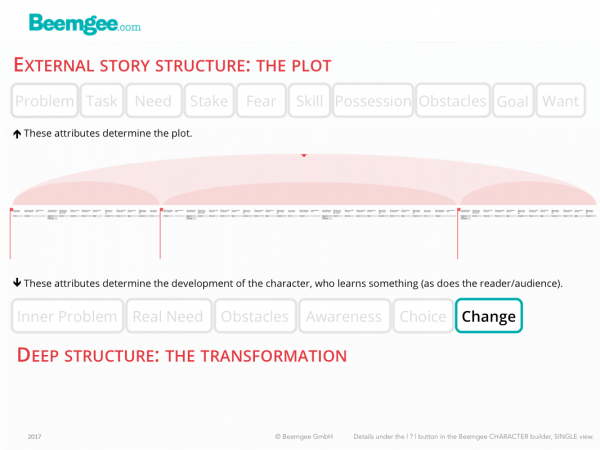
A story, pretty much by definition, describes a change. Indeed, every single scene does.
The most fundamental change that stories tend to describe is one of recognition of truth. What is not known at the beginning of the story is recognised and thus becomes known at the end. This is obvious in crime stories, but holds true for almost all other stories too. The story therefore amounts to an act of learning. Often the learning curve is observable in the protagonist, who tends to be wiser at the end than at the beginning. But the point is really that the recipient, the reader or viewer, is actually the one doing the learning – through experiencing the story.
So within a story, what changes?
At the very least,
- one of the characters, usually the protagonist
- often other characters too
- sometimes the whole story-world
(more…)
In most stories, what a character really needs is growth.
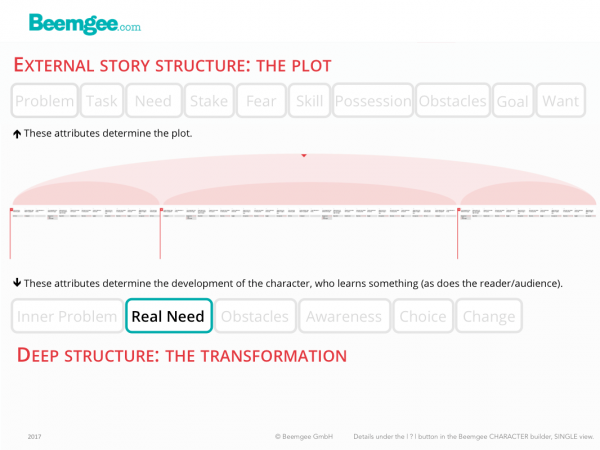
Characters display flaws or shortcomings near the beginning of the story as well as wants. What they really need to do in order to achieve what they want is likely to be something they need to become aware of first.
The real need relates to the internal problem in the same way the perceived need relates to the external problem. The character has some sort of dysfunction that really needs to be repaired.
That means the audience or reader may become aware of a character’s real need long before the character does.
To recap: The usual mode in storytelling has a character consciously responding to an external problem with a want, a goal, and a number of perceived needs. Unconsciously, that character may well have a character trait that amounts to an internal problem, out of which arises that character’s real need – i.e. to solve the internal problem.
So if a character is selfish, the real need is to learn selflessness. If the character is overly proud, then he or she needs to gain some humility. In the movie Chef, the father neglects his son emotionally – his real need is to learn to involve the child in his own life. The audience sees this way before the Chef does.
Even stories in which the external problem provides the entertainment – and with that the raison d’être of the story – may profit from(more…)
A character with a goal needs to do something in order to reach it.
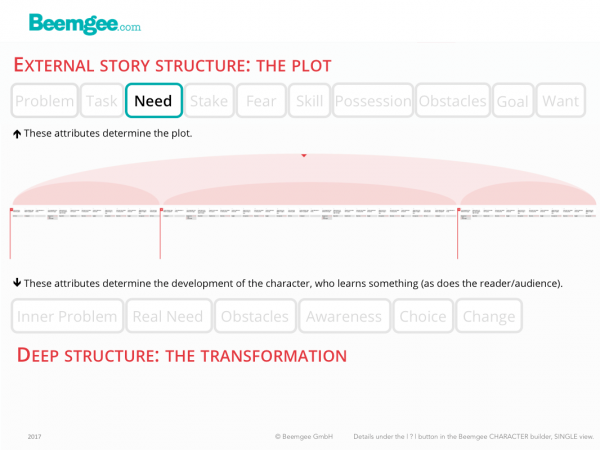
The outward needs of a character – things she needs to acquire or achieve in order to reach the goal – divide the story journey into stages.
In storytelling, characters usually know they have a problem and there is usually something they want. They tend to set themselves a goal which they believe will solve their problem and get them what they want.
In order to get to the goal, the character will need something. Some examples: If the goal is a place, a means of transportation is necessary to get there. If we can’t rob the bank alone, we’ll have to persuade some allies to join our heist. If the goal is defeating a dragon, then some weapons would be helpful. If magic is needed, we’ll have to visit the magician to pick some up.
While the perceived need might be an object or a person, it usually requires an action. We’ll need a car, so do we buy one or steal one? We’ll need a sword, so do we pull one out of a stone or go to the blacksmith? If we need help, who do we ask and how do we talk them into joining us? We’ll need magic, but how do we find a magician? Ask an elf or go to the oracle for advice?
So, once the(more…)
In storytelling, one of the most far-reaching decisions an author must make is how to narrate the story. Or: Who will be the narrator?
While not a traditional archetype, and in many cases not even a participating character, the narrator is never really quite the same entity as the author either. Standard narrator types are:
- first-person, where usually the protagonist tells his or her own story
- third-person limited, where a narrator tells a story from one character’s point of view only, meaning that the audience/reader is not told of any events that this character is unaware of
- third-person omniscient, where the narrator can relate what any of the characters are doing and thinking, and is not limited in what to present to the audience/reader
In film, first person and third-person limited effectively amount to the same thing: the audience gets only one person’s perspective on the story (there is also the first-person camera angle, but rarely is an entire film presented that way). In prose, first and third person is the difference between “I did this” and “she (or he) did that”. This is a stylistic choice. In the sense of what the narrator knows and tells, there is not necessarily much difference.
But potentially there is. A narrator who (more…)
What’s the problem? Does the character know?
In storytelling, discrepancy between a character’s awareness and the awareness-levels of others is one of the most powerful devices an author can use. “Others” refers here not just to other characters, but to the narrator and – most significantly – to the audience/reader.
Let’s sum up potential differences in knowledge or awareness:
- A character’s awareness of his or her own internal problem or motivation
- A difference between one character’s knowledge of what’s going on and another’s
- The narrator knows more about what is going on than the character
- The audience/reader knows more than the character – dramatic irony
In this post, we’ll concentrate on the first point: Awareness of the internal problem. We’ll break that down into
- Becoming Aware – the importance of the revelation
- The Story Journey – and where to place the revelation
- Surface Structure and Deep Structure
- The Need for Awareness – or, Alternatives to Revelation
Becoming Aware – the importance of the revelation (more…)
An inner or internal problem is the chance for change.
While the external problem shows the audience the character’s motivation to act (he or she wants to solve the problem), it is the internal problem that gives the character depth.
In storytelling, the internal problem is a character’s weakness, flaw, lack, shortcoming, failure, dysfunction or mistake. If you like, it is the expression of a negative character trait. Classically, this flaw may be one of excess, such as too much pride. Almost always, the internal problem involves egoism. By overcoming it, the character will be wiser at the end of the story than at the beginning. Thus the character must learn cooperative behaviour in order to be a mature, socially functioning person.
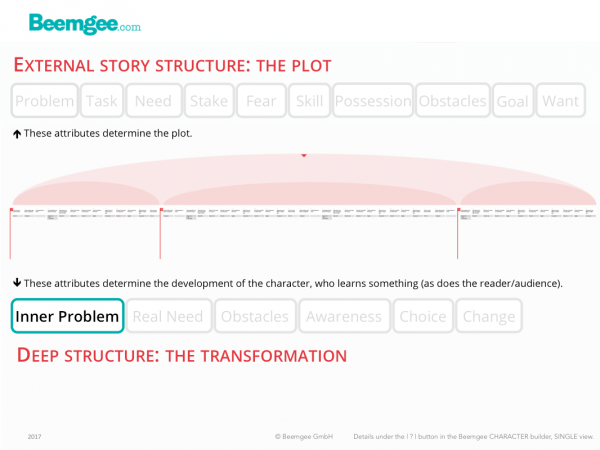
The inner problem is the pre-condition for the character’s transformation. It is the flaw, weakness, mistake or deficit that needs to be fixed. In other words, it shows what the character must learn.
Internal problems can be character traits that cause harm and hurt to others. They can be anti-social. And internal problems can also harm the character. They can be detrimental to his or her solving the external problem.
The Internal Problem of a character is revealed to the audience in scenes that show the symptoms of the flaw for the character and her environment. It then results in internal obstacles, where the character’s flaw prevents her from progressing directly towards her goal. Furthermore, the antagonism in the story may well be a sort of symbolic manifestation of the protagonist’s internal problem.
Lack of Awareness leads to Revelation
While at the beginning of the story the internal problem is a hindrance to the character’s emotional growth and may even causes the character to hurt others, it may eventually give rise to self-revelation. The character will(more…)
In stories, characters solve problems. This is the basic principle of story.
Problems come in all shapes and sizes. What’s more, in storytelling they come from within and without. The problems that come from within are hidden, internal, and it is quite possible for a character not to be aware of them. They are typically character flaws or shortcomings.
But they are not usually what gets the story going. Most stories begin with the protagonist being confronted with an external problem.
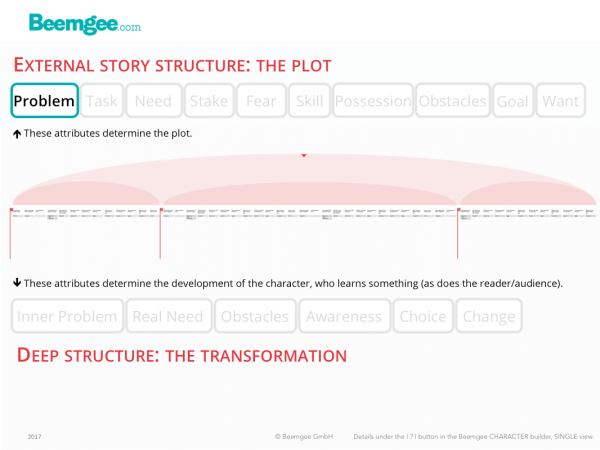
The external problem of the main character triggers the plot. It is shown to the audience as the incident which eventually incites the protagonist to action.
In some genres this is easy to see. In crime or mystery fiction, the external problem is almost by definition the crime or mystery that the protagonist has to deal with.(more…)
Stories need characters. What the characters do creates the plot.
With a well-rounded cast of characters, the plot will almost take care of itself. A story gets energy from the dynamic that occurs between the all the characters in it. The interaction between the characters is fueled by contrast, motivations, and conflict. Put a bunch of characters in a room – i.e. on a stage, between the covers of a book, between the first and last shots of a movie – and the plot is likely to emerge on its own. As long as there are contrasts between the characters and their motivations, conflict will arise.
So how does an author cast the characters that bring the story to life?
First of all, one character is rarely enough. Almost all stories need several characters. Even Robinson Crusoe couldn’t hold out alone. It’s the interplay between characters that creates interest. For interplay, read conflict.
Conflict in storytelling does not mean fights and battles. It means a conflict of interests.
Characters become characters because they have interests. Their interests make them do what they do, and this doing is what drives the plot.
What does that mean?
It means characters are motivated. They(more…)
Theme is a binding agent. It makes everything in a story stick together.
To state its theme is one way of describing what a story is about. To start finding a story’s theme, see if there is a more or less generic concept that fits, like “reform”, “racism”, “good vs. evil”. The theme of Shakespeare’s Othello is jealousy.
Once this broadest sense of theme is established, you could get a little more specific.
Since a theme is usually (though not always) consciously posited by the author, it has some elements of a unique and personal vision of what is the best way to live. At best, this is expressed through the structure of the story, for instance by having the narrative culminate in a choice the protagonist has to make. The choices represent versions of what might be considered ways to live, or what is “right”.
But beware! This is a potential writer trap. See below.
How story expresses theme
Theme is expressed, essentially, through the audience’s reaction to how the characters grow. A consciously chosen theme seeks to convey a proposition that has the potential to be universally valid. Usually – and this is interesting in its evolutionary ramifications – the theme conveys a sense of the way a group or society can live together successfully.(more…)
Archetypes in stories express patterns.
While plots may be “archetypal” when they exhibit certain forms, in this post we are concerned with character archetypes.
In modern storytelling, to consider them as archetypes might suggest a bit of a corset, perhaps even a straightjacket for the characters. For today’s author, to present a character as an archetype does not seem conducive to achieving psychological verisimilitude.
But an archetype is not the same as a stereotype. An advisor or mentor does not need to be a wise old man like Obi-Wan Kenobi. And an antagonist does not need to be a baddy.
Consider archetypes as powers within a story. Like planets in a solar system, they have gravity and they therefore exert force as they move.
Archetypes denote certain general roles or functions for characters within the system of the story. There is ample room for variation within each role or function. Boundaries between one archetype and another may be fuzzy. And it is possible for one character to stand for more than one archetype.
Archetypes Through The Ages
(more…)
One of the most important choices an author must make concerns Point of View.
In storytelling, people use the term Point of View (or PoV) to refer to different things. We’ve narrowed it down to four definitions:
- The overall perspective from which a story is told
- The scene by scene perspective of a story
- The narrator’s point of view
- Attitude or belief of the author
Overall perspective
The entire Star Wars saga is, in very general terms, told from the point of view of the two characters that have least status: the robots C-3PO and R2-D2. They are not present in every single scene, but they are part of the overall course of events – and in a ironic tip of the hat to their function of providers of overall point of view, George Lucas has C-3PO relate the entire story so far to the Ewoks in Return of the Jedi.
George Lucas borrowed the idea from Akira Kurosawa’s The Hidden Fortress, which tells a story of generals and princesses from the point of view of two peasants. These two are involved in the action, but understand less about what they see going on than the audience does.(more…)
More than any other part of a story, the beginning has to grab the audience’ or reader’s attention.
In the beginning, before audience or readers are emotionally involved and concerned about the fates of the characters, the danger of them turning away from the story is greatest.
Now, there’s more to a beginning than the kick-off event. While being an attention grabber, the entire first section of a story also has to establish the following:
- Who the story is about
- What the story is about
- Where the story takes place
That sounds self-evident, but all the elements needed to answer those three points amount to an awful lot of information. And at this stage, the audience or readers are not yet patient or forgiving, because they are not yet emotionally hooked.
In this post we will:
- look at the who/what/where
- determine the two key events that the first section of a story must include
- provide a checklist of all the elements the first part of a story requires
Who/what/where
(more…)
It’s the way you tell it
Narrative is the choice of which events to relate and in what order to relate them – so it is a representation or specific manifestation of the story, rather than the story itself. The easy way to remember the difference between story and narrative is to reshuffle the order of events. A new event order means you have a new narrative of the same story.
Narrative turns story into information, or better, into knowledge for the recipient (the audience or reader). Narrative is therefore responsible for how the recipient perceives the story. The difficulty is that story, like truth, is an illusion created by narrative.
What does that mean?
First, let’s state some basics as we understand them here at Beemgee: a story consists of narrated events; events consist of actions carried out by characters; there is conflict involved; one and the same story may be told in different ways, that is, have varying narratives.
Note that we are talking here about narrative in the dramaturgical sense – not in the social sense. Like the term “storytelling”, the word “narrative” has become a bit of a buzzword. We are not referring here to open “social narratives” such as “the American narrative”. We are pinpointing the use of the term for storytellers creating novels, films, plays, and the like. These tend in their archetypal form to be closed narratives with a beginning, a middle, and an end.
A narrative may present the events of the story in linear, that is to say chronological order or not. But the story remains the story – even if it is told backwards.(more…)
Narrative is made of successive events.
Narrative is the order in which the author presents the story’s events to the recipient, i.e. the audience or reader. Chronology is the order of these events consecutively in time. Some people use terms from Russian Formalism, Syuzhet and Fabula, to make the distinction.
While the convention is linear, i.e. to relate the story’s events consecutively in time, that is chronologically, we are also very used to narratives which move certain events around. An event may be moved forward, meaning towards the beginning of the narrative, perhaps even to be used as a kick-off. Or possibly events may be withheld from the audience or reader and pushed towards the end, perhaps to create a revelation late in the narrative for a surprise effect – though this technique often feels cheap. Also, an author may use flashbacks to insert backstory events from the past, the past being all relevant events that are prior to the events in the narrative.
As authors, when we begin composing a story, we(more…)
How to describe a full plot event.
We’ll talk here about describing events, since the usual term scene is more general and has different meanings for different media. Furthermore, a scene may conceivably contain more or less than one entire event.
An event in a story requires three elements: characters, function, and (perhaps most importantly) a difference between expectation and result.
In describing each plot event, it is useful to consider the six wh- questions as a guide: Who does what to whom, where, when and why? With this approach, each plot event gains its own logline, which is a good exercise since it forces you as an author to figure out just what dramatic function each plot event has in the context of the overall narrative.
Characters
Characters causing events make story. As(more…)
How aware are you of the creative process while writing?
Do you really consciously control what comes out of your fingers onto the page?
Even when writing happens “naturally”, while the words are pouring forth, the author is probably already performing a first level check that precedes the more detached and critical control of rewriting. If you want to make yourself more conscious of this process, consider putting an imaginary parrot on your shoulder every time you sit down to write.
A parrot?
Well, the creature of your choice. At Beemgee, it’s a parrot.
The parrot reads what you write as you write it and squawks a running commentary into your ear. It might commend a good sentence or it might censure. It might suggest alternative words or phrases. It may like or hate a paragraph.
The parrot has three main hobbyhorses: relevance, surprise, and recognition.
Relevance – (more…)
Stories are about people. Even the ones about robots, or rabbits, or whatever.
If you’re thinking about composing a story, you will probably have some characters in mind that will be performing the action of the story. In stories, action and actors (in the sense of someone who does something) are pretty much the same thing looked at from two differing perspectives, as we have noted in our post Plot vs. Character.
What sets characters in fiction apart from people in life is that characters tend to fulfil narrative functions in their story. People, on the other hand, live their lives by acting naturally according to the dictates of their personality. A story is a more or less enclosed unity, while an individual’s life is part of a greater whole. Only in retrospect do we sometimes overlay a narrative onto the biography of an individual – because we tend to feel happier when we perceive structure or direction in the lives of others or indeed our own. We can extract more meaning out of a life that can be told with structure and direction. In fact, there is no way of recounting a person’s biography without making choices concerning structure. If we’re honest, even the choice of which events to relate and how to relate them injects a fair amount of fiction into the story of a life, especially when that life is our own as we tell it to others or ourselves.
Many stories focus primarily on one protagonist. In fiction at least, the protagonist is usually wiser at the end of the story than at the beginning. The(more…)
Some people say they don’t like plot.
For some people, plot is like a dirty word. They prefer their stories to concentrate on character. Or premise. Or language. It is action movies or thrillers by Michael Crichton or Robert Ludlum that have plots.
At Beemgee, we believe that the four pillars that hold a story up are plot, character, premise, and language – with conflict as girders. Every story, no matter how “good” or “bad”, exhibits all four of these pillars. No story can really go without any one of them.
We have not found a single work of fiction in any medium or genre that does not have a plot. Ulysses has a plot. The Sound And The Fury has a plot. Even the most famous attempt in literary history to shun plot, Tristram Shandy by Laurence Sterne, did not manage to avoid describing events and characters. Its language is beautiful and its premise, of course, is the attempt to shun plot.
There is an intimate relationship(more…)
Inventing a story that has no backstory is about as easy as finding a perfect rhyme for the word orange.
That is, next to impossible.
Backstory is the stuff that went on before the story begins, or more precisely, before the kick-off event. As such, backstory might better be called “pre-story”. It is a necessary component of any story.
After all, the characters come from somewhere – they have pasts, they have histories. These histories have shaped them into who they are, which determines their actions now, in the time of the story. These actions are the source of the events of the story. So some part of the characters’ histories will be relevant to the story – and this bit of information or knowledge needs to be passed on to the audience or reader. That’s why so many stories have “campfire scenes”. (more…)
Narrative consists of successive events.
One recognizable convention from film is what we might call the kick-off event. It is the opening scene, the very first item in the narrative. This is not to be confused with the inciting incident.
We’ll refer to the kick-off event as the initial scene, and whatever the medium – page, stage, or screen – it ought to capture the audience’s or reader’s attention.
The kick-off event can be drawn from virtually anywhere in the event chronology – like a “capsule” of plot pulled out from the narrative. It may open up some questions to arouse our curiosity, or tell us something about a major character that will become relevant much later. It can throw the audience or reader, the recipient of the story, in medias res, or it can build up slowly to set the scene and establish a mood. This first event(more…)
We humans have a built-in predisposition to expect agency.
We look for the person or thing responsible for any action or phenomena we experience; we seek to ascribe “agency” to what we perceive. What this means is that when we notice that something happened, we tend to look for the cause of the event. This probably has a simple evolutionary explanation. If we hear a rustle in the bush behind us, we immediately turn around to see what moved. This reflex is a safety mechanism to detect threats. Before homo sapiens lived in houses, the individuals for whom this reflex worked most efficiently probably lived longer, and thus had better chances of passing on their genes. The point is, we assume that something or someone caused the phenomenon (the rustle) and seek to attribute it to an agent. If we are sitting in our living room and hear a floorboard creak in the hall, we would want to know what caused it too.
This safety mechanism has all sorts of ramifications. It influences(more…)









